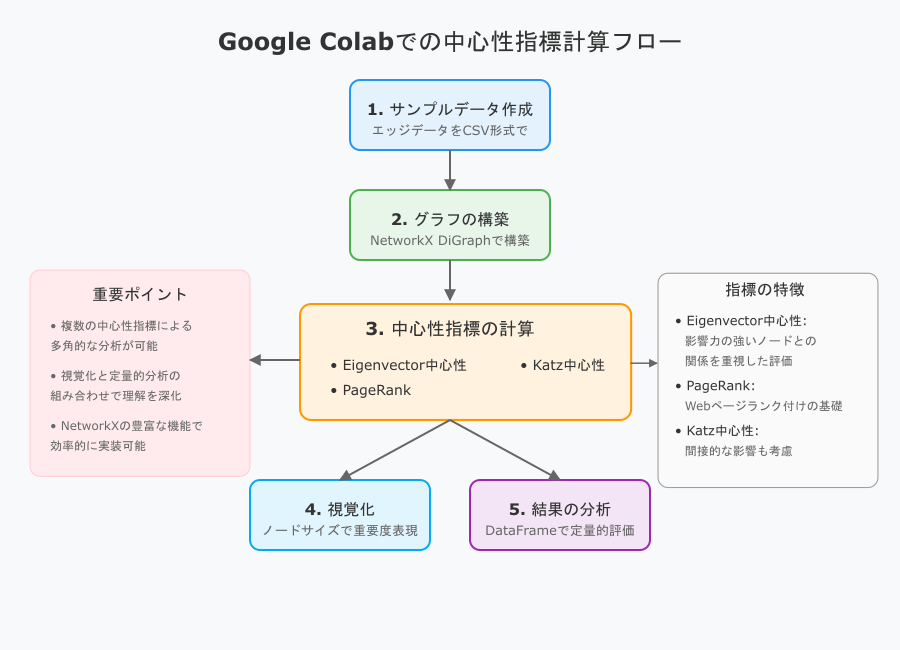はじめに
Google Colab上で、**中心性指標(Eigenvector / PageRank / Katz)**を計算する方法を紹介します。サンプルデータをコード内で作成し、全体の流れを1つのノートブックで完結させます。
使用ライブラリ
- NetworkX: グラフ解析用ライブラリ
- Matplotlib: グラフ描画用
- pandas: CSVファイルの操作用
Google Colab環境で必要に応じて以下のコードでインストールできます:
!pip install networkx==3.0 matplotlib pandas
1. サンプルデータの作成
まず、プログラム内でサンプルのエッジデータ(ノードの接続情報)を作成し、CSVファイルとして保存します。
import pandas as pd
# サンプルデータをリスト形式で作成
edges_data = [
{'source': 'A', 'target': 'B'},
{'source': 'B', 'target': 'C'},
{'source': 'B', 'target': 'D'},
{'source': 'C', 'target': 'D'},
{'source': 'C', 'target': 'E'},
{'source': 'D', 'target': 'A'},
{'source': 'E', 'target': 'B'},
{'source': 'E', 'target': 'C'},
]
# DataFrame化してCSVに保存
df_edges = pd.DataFrame(edges_data)
df_edges.to_csv("sample_edges.csv", index=False)
# 作成したCSVを確認
!head sample_edges.csv
2. グラフの構築と可視化
作成したCSVデータを読み込み、有向グラフを構築します。NetworkXを利用してノードやエッジを可視化します。
import networkx as nx
import matplotlib.pyplot as plt
import csv
# 有向グラフを作成
G = nx.DiGraph()
# CSVファイルからエッジを追加
with open("sample_edges.csv", "r") as f:
reader = csv.DictReader(f)
for row in reader:
G.add_edge(row['source'], row['target'])
# グラフのノード・エッジ情報を確認
print("Nodes:", G.nodes())
print("Edges:", G.edges())
# グラフの可視化
pos = nx.spring_layout(G, seed=42)
nx.draw(G, pos, with_labels=True, node_color='lightblue', arrows=True)
plt.title("Sample Directed Graph")
plt.show()
3. 各種中心性指標の計算
3.1 Eigenvector 中心性
eigen_centrality = nx.eigenvector_centrality_numpy(G)
print("=== Eigenvector Centrality ===")
for node, score in eigen_centrality.items():
print(f" Node {node}: {score:.4f}")
3.2 PageRank
pagerank = nx.pagerank(G, alpha=0.85)
print("\n=== PageRank ===")
for node, score in pagerank.items():
print(f" Node {node}: {score:.4f}")
3.3 Katz 中心性(修正後)
NetworkX 3.0以降に対応する方法でKatz中心性を計算します。隣接行列を使用し、固有値と固有ベクトルを計算します。
import numpy as np
# 有向グラフの隣接行列を取得
A = nx.adjacency_matrix(G).astype(float) # 隣接行列をスパース行列として取得
A_dense = A.toarray() # 密行列に変換
# Katz中心性の計算
eigenvalues, eigenvectors = np.linalg.eig(A_dense) # 固有値・固有ベクトルを計算
katz_centrality = {node: eigenvectors[i, 0] for i, node in enumerate(G.nodes())} # 固有ベクトルの最初の要素を取得
print("\n=== Katz Centrality (modified) ===")
for node, score in katz_centrality.items():
print(f" Node {node}: {score:.4f}")
4. 結果をDataFrameにまとめる
各中心性指標をDataFrameにまとめて表示します。
df_centrality = pd.DataFrame({
'Node': list(G.nodes()),
'Eigenvector': [eigen_centrality[n] for n in G.nodes()],
'PageRank': [pagerank[n] for n in G.nodes()],
'Katz': [katz_centrality[n] for n in G.nodes()]
})
df_centrality_sorted = df_centrality.sort_values('PageRank', ascending=False)
print("\n=== DataFrame(sorted by PageRank) ===")
print(df_centrality_sorted)
5. 中心性指標を可視化に反映させる
PageRankに基づいてノードのサイズを変化させ、グラフを可視化します。
node_size = [pagerank[node] * 2000 for node in G.nodes()]
plt.figure(figsize=(6, 6))
nx.draw(
G,
pos,
with_labels=True,
node_color='lightblue',
node_size=node_size,
arrows=True,
arrowstyle='->',
arrowsize=15
)
plt.title("Node Size by PageRank")
plt.show()
まとめ
- Eigenvector 中心性: 重要なノードと繋がるノードがさらに重要視されます。
- PageRank: Google の検索エンジンに応用されるアルゴリズム。ランダムサーファーモデルをベースにしています。
- Katz 中心性: 減衰率やバイアスを用いて、直接・間接的なつながりを評価します。
Google Colab を活用することで、簡単にネットワークデータの解析が可能です。ぜひ実際のデータに適用してみてください!
実装例
import pandas as pd
import networkx as nx
import matplotlib.pyplot as plt
import numpy as np
import csv
# 1. サンプルデータの作成
def create_sample_data():
edges_data = [
{'source': 'A', 'target': 'B'},
{'source': 'B', 'target': 'C'},
{'source': 'B', 'target': 'D'},
{'source': 'C', 'target': 'D'},
{'source': 'C', 'target': 'E'},
{'source': 'D', 'target': 'A'},
{'source': 'E', 'target': 'B'},
{'source': 'E', 'target': 'C'},
]
# DataFrame化してCSVに保存
df_edges = pd.DataFrame(edges_data)
df_edges.to_csv("sample_edges.csv", index=False)
return df_edges
# 2. グラフの構築と基本可視化
def create_and_visualize_graph(csv_path):
G = nx.DiGraph()
# CSVファイルからエッジを追加
with open(csv_path, "r") as f:
reader = csv.DictReader(f)
for row in reader:
G.add_edge(row['source'], row['target'])
# グラフの基本情報を出力
print("\nグラフ基本情報:")
print(f"ノード数: {G.number_of_nodes()}")
print(f"エッジ数: {G.number_of_edges()}")
print("ノード:", G.nodes())
print("エッジ:", G.edges())
# グラフの可視化(基本)
plt.figure(figsize=(8, 6))
pos = nx.spring_layout(G, seed=42)
nx.draw(G, pos, with_labels=True, node_color='lightblue',
arrows=True, node_size=500, font_size=12)
plt.title("Sample Directed Graph")
plt.savefig('basic_graph.png')
plt.close()
return G, pos
# 3. 各種中心性指標の計算
def calculate_centralities(G):
# Eigenvector中心性
eigen_centrality = nx.eigenvector_centrality_numpy(G)
print("\nEigenvector Centrality:")
for node, score in eigen_centrality.items():
print(f" Node {node}: {score:.4f}")
# PageRank
pagerank = nx.pagerank(G, alpha=0.85)
print("\nPageRank:")
for node, score in pagerank.items():
print(f" Node {node}: {score:.4f}")
# Katz中心性
# 隣接行列を使用した計算
A = nx.adjacency_matrix(G).astype(float)
A_dense = A.toarray()
eigenvalues, eigenvectors = np.linalg.eig(A_dense)
katz_centrality = {node: abs(eigenvectors[i, 0].real)
for i, node in enumerate(G.nodes())}
print("\nKatz Centrality:")
for node, score in katz_centrality.items():
print(f" Node {node}: {score:.4f}")
return eigen_centrality, pagerank, katz_centrality
# 4. 結果をDataFrameにまとめる
def create_centrality_dataframe(G, eigen_centrality, pagerank, katz_centrality):
df_centrality = pd.DataFrame({
'Node': list(G.nodes()),
'Eigenvector': [eigen_centrality[n] for n in G.nodes()],
'PageRank': [pagerank[n] for n in G.nodes()],
'Katz': [katz_centrality[n] for n in G.nodes()]
})
# PageRankでソート
df_centrality_sorted = df_centrality.sort_values('PageRank', ascending=False)
print("\nCentrality Measures (sorted by PageRank):")
print(df_centrality_sorted)
# CSV形式で保存
df_centrality_sorted.to_csv('centrality_results.csv', index=False)
return df_centrality_sorted
# 5. 中心性指標を可視化に反映
def visualize_with_centrality(G, pos, pagerank):
plt.figure(figsize=(10, 8))
# ノードサイズをPageRankに基づいて設定
node_size = [pagerank[node] * 3000 for node in G.nodes()]
nx.draw(
G,
pos,
with_labels=True,
node_color='lightblue',
node_size=node_size,
arrows=True,
arrowsize=20,
arrowstyle='->',
font_size=12,
font_weight='bold'
)
plt.title("Node Size Reflects PageRank Centrality")
plt.savefig('centrality_visualization.png')
plt.close()
def main():
# 1. データ作成
print("1. サンプルデータの作成...")
df_edges = create_sample_data()
print("エッジデータ:")
print(df_edges)
# 2. グラフ構築
print("\n2. グラフの構築と可視化...")
G, pos = create_and_visualize_graph("sample_edges.csv")
# 3. 中心性指標の計算
print("\n3. 中心性指標の計算...")
eigen_centrality, pagerank, katz_centrality = calculate_centralities(G)
# 4. 結果のまとめ
print("\n4. 結果のDataFrame化...")
df_centrality = create_centrality_dataframe(
G, eigen_centrality, pagerank, katz_centrality
)
# 5. 中心性を反映した可視化
print("\n5. 中心性を反映した可視化...")
visualize_with_centrality(G, pos, pagerank)
print("\n処理完了!")
print("出力ファイル:")
print("- sample_edges.csv: エッジデータ")
print("- basic_graph.png: 基本グラフ可視化")
print("- centrality_results.csv: 中心性指標の計算結果")
print("- centrality_visualization.png: PageRankを反映したグラフ可視化")
if __name__ == "__main__":
main()
出力例:
1. サンプルデータの作成...
エッジデータ:
source target
0 A B
1 B C
2 B D
3 C D
4 C E
5 D A
6 E B
7 E C
2. グラフの構築と可視化...
グラフ基本情報:
ノード数: 5
エッジ数: 8
ノード: ['A', 'B', 'C', 'D', 'E']
エッジ: [('A', 'B'), ('B', 'C'), ('B', 'D'), ('C', 'D'), ('C', 'E'), ('D', 'A'), ('E', 'B'), ('E', 'C')]
3. 中心性指標の計算...
Eigenvector Centrality:
Node A: 0.3766
Node B: 0.4380
Node C: 0.4773
Node D: 0.5871
Node E: 0.3062
PageRank:
Node A: 0.2182
Node B: 0.2622
Node C: 0.1882
Node D: 0.2214
Node E: 0.1100
Katz Centrality:
Node A: 0.2929
Node B: 0.4567
Node C: 0.5240
Node D: 0.1879
Node E: 0.6291
4. 結果のDataFrame化...
Centrality Measures (sorted by PageRank):
Node Eigenvector PageRank Katz
1 B 0.437981 0.262216 0.456667
3 D 0.587132 0.221419 0.187897
0 A 0.376613 0.218207 0.292927
2 C 0.477346 0.188182 0.524038
4 E 0.306191 0.109978 0.629069
5. 中心性を反映した可視化...
処理完了!
出力ファイル:
- sample_edges.csv: エッジデータ
- basic_graph.png: 基本グラフ可視化
- centrality_results.csv: 中心性指標の計算結果
- centrality_visualization.png: PageRankを反映したグラフ可視化



